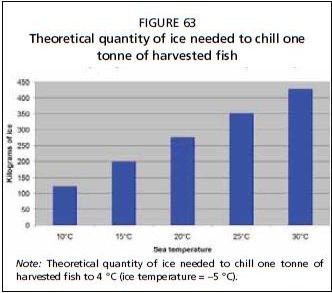PROCESSING AND PACKAGING
Fish harvesting, processing and packaging must be carried out while maintaining the "cold chain" in each phase of the process; ice is essential to this process. "Cold chain" is a temperature-controlled sequence of storage and distribution processes that usually applies to food processing. In the case of fresh seafood,
the fish must be maintained at temperatures below 4 °C from the time of harvest until they are shipped.
The cold chain integrity should be validated and managed through a proper Hazard Analysis and Critical Control Points (HACCP) procedure, where all the steps from harvesting to shipment are analysed. This procedure allows the farmer to: (i) assess possible risks to safe storage and/or contaminations; (ii) identify possible critical points of the process and the relative parameters to be controlled; (iii) define acceptable standards for the parameters; and (iv) identify corrective actions to take in case of non- standard parameters posing a threat.
In contrast with other aquaculture systems, cage aquaculture harvesting requires the transport of equipment, ice and fish by vessels. This transport phase can be very lengthy, and it requires the purchase and proper use of the correct equipment, and an awareness of proper fish handling and storage practices.
Ice
An efficient ice machine can provide flaked ice sufficient for harvesting and packaging operations. Ice is used for killing and packaging the fish, as well as to maintain integrity of the cold chain during the process.
Before harvesting the fish, insulated bins should be prepared with a sufficient amount of ice.
FIGURE 63
Theoretical quantity of ice needed to chill one tonne of harvested fish

Fish can be humanely killed by thermal shock using ice/water slurry. The ice slurry is prepared by adding seawater to the bins with ice. For each tonne of fish, the required amount of ice will be proportional to the seawater's temperature. The higher is the temperature, the greater the amount of ice needed in the bins.
As an example, Figure 63 provides the theoretical amount of ice necessary to cool one tonne of fish to 4 °C, assuming that the temperature of the ice is -5 °C, and that 200 litres of seawater are added to make the ice slurry.
The amount of ice needed for a harvest will depend on the following parameters: ? insulation of the bins;
the external air and water temperatures;
exposure of the bins to sunlight;
? the distance of the cage site from the jetty;
? the duration of the whole operation.
Fish must be kept chilled in the bins. The temperature of the fish should be checked regularly, and ice should be added to the bins whenever the temperature exceeds 4 °C. For this reason, spare ice stored in a dedicated bin should be included among the harvesting equipment.
Flake ice machines may be preferable to other ice machines for ice production because flake ice has a larger surface-area-to-volume ratio. This means that the heat exchange will be faster during harvesting and packaging operations. Drinkable freshwater should be used, rather than saltwater, for packaging fish because ice made with the latter has a lower melting temperature that may damage the skin of the fish.
As harvesting operations are carried out on boats (usually equipped with a crane), the risk of chemical contamination of the harvest should be considered and minimized. Possible causes of chemical contamination include oil spillage from the crane or fuel or grease contamination. To avoid these risks:
The crane must be kept in good working order and all the hydraulic components checked regularly.
The harvesting team should have dedicated clothes and equipment used only for harvesting.
• Fish that have fallen onto the boat's deck should not be stored in the fish bins, but placed into a separate bin and examined later, upon docking, for any possible contamination.
• Contact between the crane's hook, cage and wire with the fish or bins should be avoided.
• Any kind of vessel maintenance operation while harvesting should be avoided.